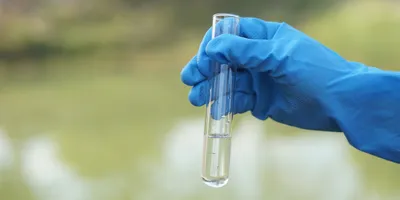Understanding the degree of PFAS contamination in complex samples is a very challenging characterization. Labs investigating compounds beyond the standard targeted molecules need advanced tools and efficient workflows to better understand the full scope of PFAS contamination.
To learn more about recent improvements in PFAS analysis workflows, we sat down with Carl Fisher, PhD, product marketing manager, and Ed George, global EFS regulatory strategy and KOL manager at Thermo Fisher Scientific.
Q: How are evolving regulatory frameworks, such as EPA Method 1621, increasing the need for PFAS testing across industries like water treatment and manufacturing?
A: EPA Method 1621 is directed mainly at wastewater and non-potable water, and it is anticipated that regulated limits will be established soon. It casts a wider net than targeted methods, trying to capture PFAS compounds that may potentially be present rather than relying on the narrow focus that is the goal of other approved PFAS methods.

Carl Fisher
As new methods are developed, it opens a wide array of compounds to be tested. With 1621, the sample types that are eligible for analysis expand beyond drinking water, which is a relatively clean matrix, to other, less pristine waters. These potentially more contaminated waters are challenging for existing methods because of additional sample constituents, such as suspended solids that are trapped by the granular activated carbon columns and then combusted as part of analysis. Such particles might cause a blockage or, if filtered, their potential contribution will not be measured. Methods using other sample preparation steps, such as solid phase extraction, also accommodate larger varieties of samples.
Q: What are the key limitations of current targeted testing methods and how is mass spectrometry addressing those gaps?
A: Current targeted PFAS methods are limited to lists of PFAS that are commercially available for these quantitative methods. For example, EPA method 1633 is limited to 44 compounds. Other reference standards are slowly becoming available; however, we know that there are potentially thousands of PFAS compounds and their transformation products that could be present in environmental samples. As a result, these methods provide an incomplete picture of what is actually or potentially present in a sample.
Mass spectrometry techniques using high-resolution accurate mass (HRAM) with MS/MS will provide a more comprehensive view of PFAS in a sample, as it allows both targeted and non-targeted analysis in a single analytical run. Non-targeted analyses equip researchers with additional insights of potential contaminants outside of regulatory requirements that could still be harmful or warrant additional research. The data is processed using a software package equipped with tools allowing the user to sort potential PFAS candidates, followed by the ability to provide tentative identification at defined confidence levels. Another advantage of this technology is the ability to perform retrospective analysis of previously acquired data for the exact masses of other suspected contaminants.
Q: What role does combustion ion chromatography play in complementing mass spectrometry for PFAS analysis?
A: Approved PFAS methods use targeted analysis of a very limited number of compounds (~44). Combustion ion chromatography (C-IC), as part of the EPA 1621 workflow, is able to detect the presence of a much larger population of PFAS compounds because it is not limited to this small subset of known compounds. The limit for this method is the binding to the activated carbon cartridges, which typically has the best recoveries for compounds with carbon chains from C4 to C8. C-IC can also be used to determine the fluorine present from samples prepared using extractable organic fluorine (EOF) determined from solid phase extraction (SPE). This broadens the range of compounds captured to give a more expansive picture of PFAS compounds that may be present in a solution.

Ed George
For solid samples, total organic fluorine (TOF) can be determined by subtracting soluble, inorganic fluorine (IF, determined by IC) from total fluorine (TF, determined using C-IC). TOF does not depend on capture or extraction prior to analysis, so it helps researchers and scientists detect the presence of all the fluorinated compounds. However, compared to methods such as EPA method 1621, the detection limits are in the low parts per million range rather than low parts per billion. EPA 1621 has the benefit of a concentration step from a large volume of sample.
Lab Quality Management Certificate
The Lab Quality Management certificate is more than training—it’s a professional advantage.
Gain critical skills and IACET-approved CEUs that make a measurable difference.
Q: With thousands of unidentified PFAS compounds unaccounted for, what role are advanced non-targeted analytical techniques playing?
A: Non-targeted methods such as AOF or EOF using C-IC provide the ability to screen a much larger sampling of potential PFAS compounds due to the relatively inclusive nature of the capture mechanisms used, like granular activated carbon or SPE cartridges. If a general screening using C-IC indicates the likelihood of the presence of PFAS compounds, mass spectrometry techniques with HRAM can be used to identify compounds that exist beyond targeted lists to gain greater insight into the potential source(s) of contamination.
Q: What are the biggest challenges labs face when integrating non-targeted PFAS testing workflows?
A: One of the challenges with non-targeted PFAS analysis is the learning curve of the technologies involved. For C-IC, users may have never used a combustion furnace, nor ion chromatography (IC). Fortunately, in modern workflows, the analytical steps are automated so that one only needs to place a sample in an autosampler tray and the system takes care of the rest of the steps. Even the IC portion is simplified from an operator’s perspective with the use of reagent free ion chromatography (RFIC) where only water is required for reagent delivery from an eluent generator cartridge for sample elution. They benefit from the ease of use, minimal exposure to toxic chemicals, and enhanced consistency that this eluent delivery provides.
Another challenge is controlling all the components that are part of this workflow. Ideally, the software is able to control all aspects of the system so that there is no need to learn multiple platforms and thus minimize the risk of various steps going out of synch once a sequence has been started.
Q: How does automation and data analysis play a role in PFAS testing?
A: Automation increases lab efficiency, consistency, and precision while enhancing throughput by allowing unattended operation and removing potential errors that can occur when manual steps are involved. In addition, the potential for background contamination in an automated sample preparation process is greatly reduced.
Data analysis software with advanced tools for detection and confirmation will continue to play a critical role in our understanding of the scope of the PFAS problem. Ultimately, a combination of data obtained from the analytical techniques described here can be used to examine the total mass balance of organic fluorine.













